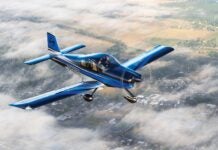Eventually the day comes when your project morphs from a project to a full-fledged airplane. If you built it and got it certified, you have to get it in the air. It might not be you at the controls on the very first flight (you want someone qualified, and you may have spent more time building than flying in the past couple of seasons), but you’ll feel the tug in your gut even so as you watch it rotate and climb away.
It certainly got me right in the pit of my stomach, and for good reason, too. After all the prep, the pre-flighting, the taxiing to burn in the brakes, the waiting for the perfect quiet, calm, clear and cool morning, after all the checking and re-checking of our specs and our expectations, as 9AB rotated, there was a puff of white smoke and a chirp that emanated from the landing gear. I was watching from 30 yards off the side of the runway at midfield, my crash ax, pry bar and fire extinguisher at hand. It sounded innocuous, as if the pilot had tapped a brake inadvertently just at rotation, skidding a main tire just a bit. Then again, it could be that something stopped spinning.
I alerted the pilot via handheld radio, and as I did so another observer (we were stationed at equal intervals along the runway) chimed in that the nosewheel seemed to exhibit a pretty good shimmy on the roll. The pilot, busy just flying the airplane to altitude and noting all of the temperatures and pressures, grunted a “Roger that” and went back to the tasks at hand.
On the ground we gathered midfield, and despite our best efforts to be positive, we ruminated over the incident, trying to figure all of the possible causes and consequences, so that before the pilot brought the airplane back around for a landing, we could at the very least advise him on possible landing techniques or alternatives. It’s what good ground crews do when left to their own devices for the 45 minutes or so of an airplane’s first flight.
Finally, the airplane, circling at 5000 feet above the field, began its descent for landing. The pilot stuck to protocol and plan, which good test pilots are wont to do, and set up a fine, stable half-flaps approach, and held the machine off the ground, bleeding airspeed, until the mains touched so gently there was hardly a chirp. He squeezed the stick back, balancing gingerly to keep the tail skid and the front wheel off the asphalt until the air loads dwindled and the nose settled–at which point the skidding began.
The high-pitched squeal of rubber and asphalt scrubbing against each other, and the violent shaking and hopping of the nosegear let everyone know it was “go time,” and we rolled toward the airplane, even as the pilot worked the brakes to get the machine stopped safely without breaking anything else. With plenty of runway to spare, the plane slowed to an easy walk, but the white smoke trail from the nosegear told the story: Something had gone terribly wrong with that component.
smoke trail from the nosegear told the story: Something had gone terribly wrong with that component.
The pilot shut down, and we surveyed the damage. One tire, skid through to the cord. One set of spacers caterwonky with a bit of scoring on the fork, and a bearing cage chewed to bits. We reconnoitered the tractor and a dolly and the tow bar and carefully rolled the beast back to the hangar.
Later that day the diagnosis came in. The airplane nosewheel had been assembled according to the original plans; however, in the past two years there had been problems (not this one in particular) with the original assembly design, and new spacers, along with a revised assembly process, had been sent out to builders. Ours had not yet been installed, most likely because of builder optimism (it seemed to be working fine the way it was). These are the lessons we take away.
All it cost us was a new tire, a new axle, bearings, bearing cage, washers and spacers and, of course, a couple of days. We were lucky. The pilot was skilled, and the airplane flew again with a nosewheel that spun freely on takeoff and landing.
Lesson learned? Look over those builder revisions you got, even the ones from years back, before you fly. Create a checklist to make sure you’ve made all the retrofits, and consider retrofitting even if you don’t think you need to. The little problems become big awful fast on a first flight. You want to nip ’em all in the bud.
http://www.blogger.com/img/videoplayer.swf?videoUrl=http%3A%2F%2Fv1.nonxt5.googlevideo.com%2Fvideoplayback%3Fid%3Dba717bfed9421e09%26itag%3D5%26begin%3D0%26len%3D86400000%26app%3Dblogger%26et%3Dplay%26el%3DEMBEDDED%26ip%3D0.0.0.0%26ipbits%3D0%26expire%3D1269277385%26sparams%3Did%252Citag%252Cip%252Cipbits%252Cexpire%26signature%3D7D55BA43F5BE73C52CA03CB44C0335E2623B6597.85546ECACF5BF4613175AB07A3EEBD840CEF5B22%26key%3Dck1&nogvlm=1&thumbnailUrl=http%3A%2F%2Fvideo.google.com%2FThumbnailServer2%3Fapp%3Dblogger%26contentid%3Dba717bfed9421e09%26offsetms%3D5000%26itag%3Dw320%26sigh%3DjcOqway3HF1cVLDvz22LI-V2we4&messagesUrl=video.google.com%2FFlashUiStrings.xlb%3Fframe%3Dflashstrings%26hl%3Den













